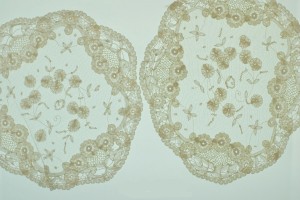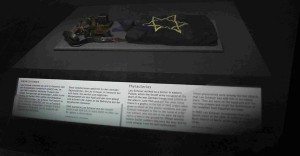
Two doilies from the Plesch family household, from the first half of the 20th century, given by Janos and Melanie Plesch in memory of Prof. Dr. Peter H. Plesch.
You can often find a number of Jewish Museum employees in the lunchtime crowd at the canteen of the European Patent Office at Hallesches Tor in Berlin. The food there is excellent; the noise, on the other hand, is excessive: rattling silverware, clattering dishes, and the voices of diners whirring together into one great drone.
In the dining room of the Berliner doctor family Plesch such a hubbub would have been unthinkable. Their secret: clatter-doilies. → continue reading

Detail of the Garden of Exile © Jewish Museum Berlin, photo: Jens Ziehe
It’s not only Jewish history in Germany that continually surprises us with its complexity: the visitors to the Jewish Museum can also be as unexpected as they are diverse. During my tours through the permanent and temporary exhibitions, I have had remarkable encounters. This year among the most unusual was with a group of theologians from the city of Qom, who came to experience the museum at the beginning of October. Most Iranian preachers and imams graduate from the theological seminary at Qom, not far from the capital Tehran and considered, in contrast to the liberal Najaf for instance, a bastion of conservative learning. → continue reading
“Axis of the Holocaust” is the designation of one of three corridors in the museum’s basement. Display cabinets are inlayed in the wall. They contain photographs, pieces of writing, and objects that convey the stories of people who survived or were murdered in the Holocaust.
They contain photographs, pieces of writing, and objects that convey the stories of people who survived or were murdered in the Holocaust.
In one window lie phylacteries and a pouch with an embroidered Star of David. These objects belonged to Leo Scheuer. He gave them to the museum shortly before his death. → continue reading


